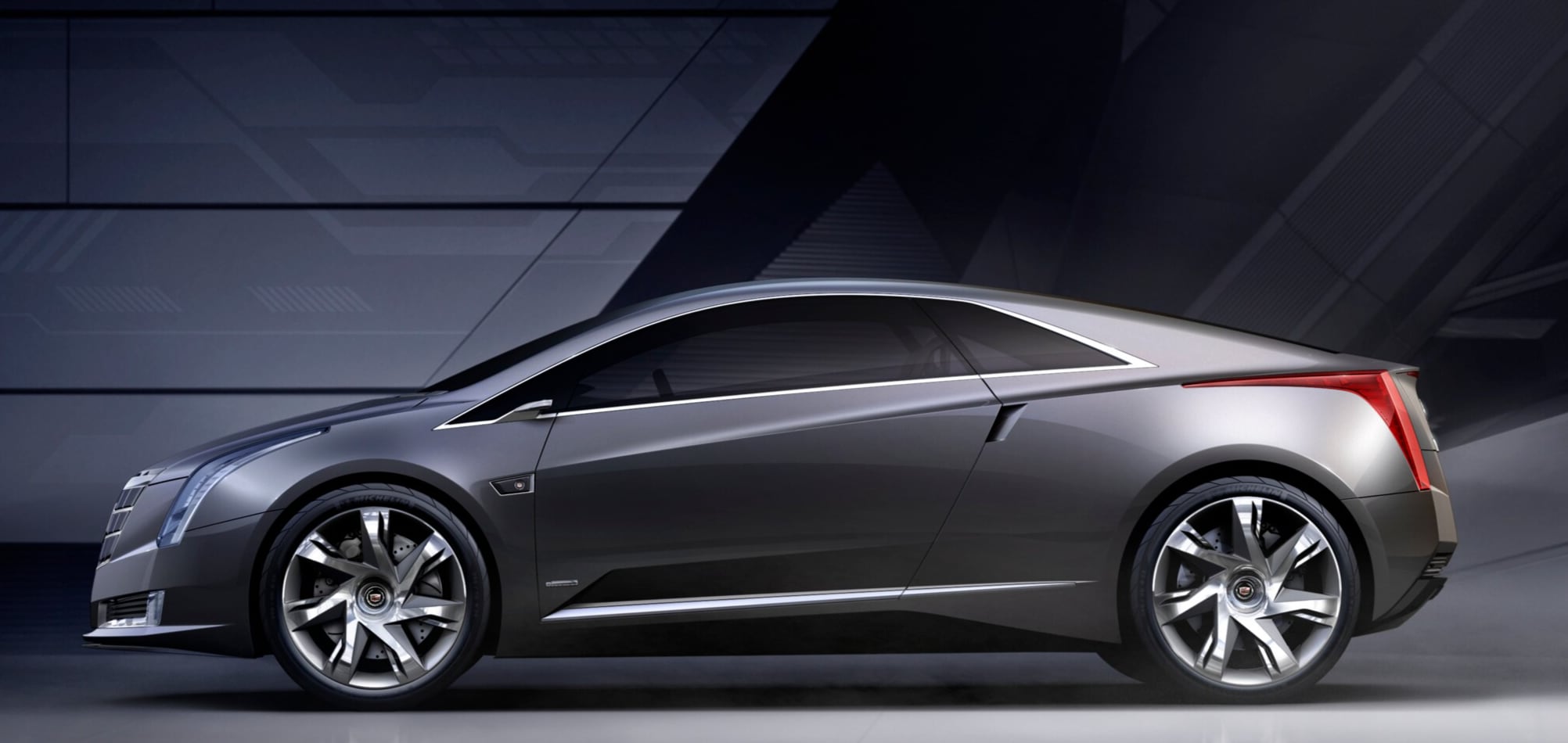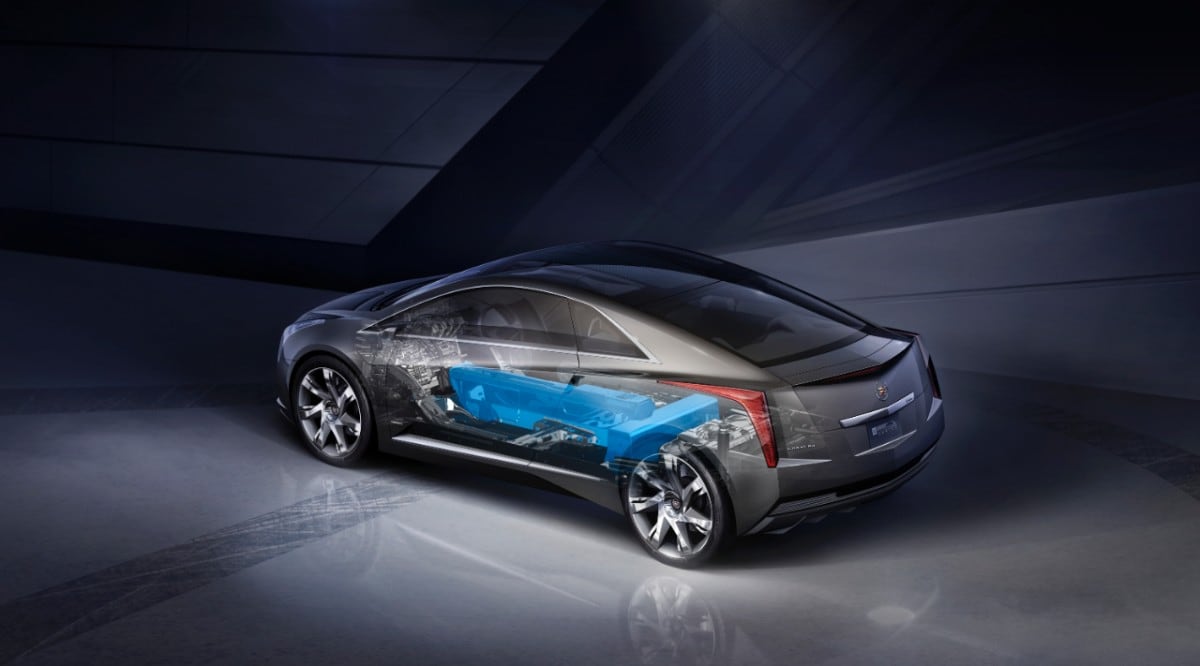
The Cadillac ELR, Cadillac’s forgotten $75,000 hybrid coupe, started as the Cadillac Converj concept. General Motors unveiled the Cadillac Converj, a 2+2 coupe concept, at the 2009 Detroit Auto Show. The car is designed with a sleek and futuristic design, featuring a sharp body line that runs from the front to the rear quarter. The interior is luxurious, with high-end materials such as white synthetic suede, black leather, and wood trim.
The Converj is powered by a technology similar to the Chevrolet Volt, using an electric motor and a 16-kWh battery pack. The motor produces 161 horsepower and 273 lb-ft of torque, allowing it to accelerate quickly and efficiently. The car can travel up to 40 miles on electricity alone before the engine kicks in and can be recharged via a household outlet.
The Converj's suspension system features GM's Magnetic Ride Control adjustable shocks, providing a stable and confident ride. The wheels are 21 inches up front and 22 inches in the rear.
Once its cousin Chevy Volt would be released in 2010, the ELR, following the 3-letter nomenclature of Cadillac’s of the time would command a premium price due to its luxurious design and advanced technology features starting in the 2014 MY. Why did it take so long to come to market?
The ELR was initially planned for production but was halted during General Motors' bankruptcy and restructuring. After a series of uncertain decisions, the company finally greenlit the ELR for production in 2014.
The ELR had similar specifications of the Volt, featuring The ELR uses a modified version of the Voltec propulsion system, which is similar to the one used in the Chevrolet Volt. The system consists of an electric motor, a four-cylinder engine, and a 16.5-kilowatt hour battery pack. The ELR has an estimated all-electric range of 37 miles and a total range of around 340 miles, according to the EPA. The car can be charged using a 120-volt travel charger, which takes around 12.5 to 18 hours to fully charge, or a 240-volt charging station, which takes around 5 hours. The ELR has a top speed of 106 mph and can accelerate from 0-60 mph in around 7.8 seconds when using the range-extending engine. The car also features regenerative braking, which can be controlled using steering wheel-mounted paddles. The EPA gave it a rating of 82 E-MPG.
The ELR features a range of premium amenities, including LED lighting, active air shutters to improve aerodynamics, and advanced headlight technology that automatically adjusts between high and low beams. The interior is designed to provide a luxurious experience, with a Bose sound system that features 10 speakers and active noise cancellation to eliminate background noise.
Optional features include advanced safety technologies, such as adaptive cruise control that can adjust speed to match traffic conditions, collision-imminent braking to help prevent accidents, and warnings for blind spots and rear cross-traffic. Additionally, the base model comes with 16-way adjustable seats, while an optional upgrade provides 20-way adjustment for added comfort and customization.
However, with a sticker price of around $75,000, (before government incentives) this was significantly higher than the Volt, which shared the same powertrain, with a price tag of around $40,000.
The 2014 ELR sold less than 3000 units total across USA and Canada, and Cadillac skipped the 2015 model year as a result.
For the 2016 MY, Cadillac made significant changes to the ELR, starting with a $10,000 price reduction. The vehicle's powertrain also received an upgrade, with the combined output of its two electric motors and gasoline four-cylinder engine increasing from 217 horsepower to 233. This boost in power was accompanied by a 1.5-second reduction in the zero-to-60 time.
The ELR's suspension system was also revamped to address torque steer and improve handling. This involved the addition of a new damper rebound spring, stiffer springs, and revised control-arm bushings. The rear twist-beam axle was also updated with stiffer bushings for its Watts linkage. The adaptive suspension was retuned to match the increased stiffness, and the steering was recalibrated. The brakes were upgraded as well, with the addition of a performance package that included summer-only performance tires, new 20-inch wheels, and Brembo four-piston front brake calipers. This package also featured a sport steering wheel and unique suspension revisions.
The 2016 ELR also gained several new safety features, including blind-spot monitoring, rear cross-traffic alert, automatic high beams, and lane-change alert. Additionally, the vehicle came equipped with a 4G LTE onboard data connection and Wi-Fi hotspot capability. The engine management software was also updated, and the regenerative braking system was reconfigured. The result was an all-electric range of 39 miles, up from 37 miles in the previous year.
However, these changes wouldn’t be enough to shake things up with ELR sales, with less than 600 sales in the US and Canada for the 2016 MY.
The ELR ultimately failed for General Motors due to the ELR being a small hybrid 2+2 coupe being offered for a premium price. There involved a certain amount of buyer education to get them into an electric vehicle to begin with, and one as impractical as the ELR was an obstacle to say the least. Its closest competitor at the time, the Tesla Model S, which had launched in the 2012 MY had started at $57k and could seat up to 5 with a range of over 200 miles, making it the standout electric vehicle of the era, overshadowing any market the ELR hoped to reel in, in its short existence.
